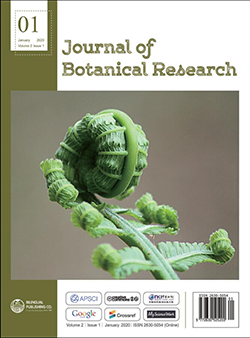-
227
-
182
-
167
-
147
-
145
Evaluation of Biomass and Vegetative Propagation of Spilanthes Oleracea Jacq. (Asteraceae)
DOI:
https://doi.org/10.30564/jrb.v2i1.1614Abstract
Spilanthes oleracea Jacq. is an herbaceous plant whose scientific literature attributes among others, anti-malarial and anti-bilharzia properties. These virtues justify the placing on the market of drugs based on the plant. Our study consisted on the one hand to evaluate the biomass of the plant on a soil of dune amended and on soil of unamended dune and to test its vegetative multiplication by transplanting, cuttings and layering. The results show that the growth of the species is greater on dune soil amended with an average biomass of 106.06 g compared to 71.06 g for un-amended soil plants. The transplanting of the plants and the layering were techniques that made it possible to multiply the plants. Spilanthes oleracea Jacq. can be produced using this agronomic data.
Keywords:
Spilanthes oleracea Jacq.; Biomass; Transplanting; Cuttings; Layering; Sand duneReferences
[1] Ang B.H., Chan L.K. Micropropagation of Spilanthes acmella L., a bio-insecticide plant, throught proliferation of multiples shoots. J. Appl. Hort., 2003, 5(2): 65-68.
[2] Gasquet M., Delmap F., Timon D.P., Keita A., Guindo M., Koita N., Diallo D., Doumbo O. - Evaluation in vitro and in vivo of a traditional antimalarial, Malarial 5. Fitoterapia, 1993, LXIV(5).
[3] Gerber E. Uber die chemischen bestandteille de parakresse (Spilanthes oleracea Jacq.). Arch. Der Pharmazie, 1903, 236: 270-289.
[4] Ghokhale V.G., Bhide B.V. Chemical investigation of Spilanthes acmella. Journal of Indian Chemical Society, 1945, 22: 250-252.
[5] Heal R.F., Rogers E.F. A suvey of plants for the insecticidal activity. Llodia, 1950, 13: 89-162.
[6] Hostetmann K., Marston A. Plants molluscicides. Phytochemistry, 1985, 24: 639-652.
[7] Johns T., Graham K., Neil Towers G.N. Molluscicidal activity of affinin and other isobutylamids from Asteraceae. Phytochemistry, 1982, 21: 2737-2738.
[8] Joshi V., Tiwari K.L., Jadhav S.K. In vitro propagation of Spilanthes acmella (L) Murr. using semisolid and liquid medium. Indian Journal of Biotechnology, 2015, 14: 112-116.
[9] Koster J.T.H. Nomenclatural changes in Spilanthes and Blainvilles with remarks and a key to the species of Spilanthes in the malay archipelago. Busmea, 1950, 6: 349-354.
[10] Ndoye S., Ndiaye B., Diop C. Analyse pédologique de la région des Niayes au Sénégal. Journal des Sciences Pour l’Ingénieur, 2006, 6: 47-55.
[11] Sarita K.V., Prakash E., Ramamurthy N., Naidu C.V.. Micropropagation of Spilanthes acmella Murr. Biologia Plantarum, 2002, 45(4): 581-584.
[12] Trecisson C. Spilanthes acmella Murr., Thèse de doctorat d’état de pharmacie, Université Paul Sabatier, Toulouse, 1988, 88.
[13] Verykokidev V. E., Becker H. Flavonoide aus Spilanthes oleracea Jacq. Arch. Der Pharmazie, 1983, 316: 815-816.




 William Diatta
William Diatta





